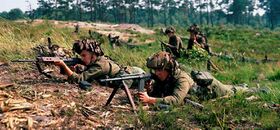Operation Alexandria
This article is incomplete because it is pending further input from participants, or it is a work-in-progress by one author. Please comment on this article's talk page to share your input, comments and questions. Note: To contribute to this article, you may need to seek help from the author(s) of this page. |
| Operation Alexandria | |||||||
|---|---|---|---|---|---|---|---|
| Part of the Scandinavia Campaign of the Seleucid Uprising | |||||||
 ERUAC Troops near the Agria Gorge | |||||||
| |||||||
| Belligerents | |||||||
|
Allied Security Forces
Other Allied Nations: | |||||||
| Commanders and leaders | |||||||
| Strength | |||||||
|
550,000 personnel 1,250 tanks 950 AFVs 3,500 guns 2,980 aircraft |
750,000 personnel 1,422 tanks 1,280 AFVs 4,200 guns 3,150 aircraft | ||||||
| Casualties and losses | |||||||
|
By August 1951:
|
By December 1951:
| ||||||
Operation Alexandria (15 March 1955 - 17 August 1955) was the codename for the Allied Strategic Counteroffensive of Southern Erebonia in an attempt to push the remnants of the Selucid forces still in Erebonia further south and into the Liberlian regions. The Imperials barely had time to prepare due to the continuous winter conditions in January and February 1955. By Spring, Allied forces had bought in new weapons and equipment in time for the offensive. The Allies had also restructured its infantry doctrine in time for the counteroffensive.
The Allies' attack had shocked the Selucids, being unable to anticipate the counteroffensive, as many planners had expected the Allied counteroffensive by summer. The operation called for several army groups around Erebonia to commit a push and attack on the remaining Selucid pockets of resistance. Although it took the Allies 5 months before Erebonia was finally secured, as the Selucids had planted deep defenses in Southern Erebonia. The end of the operation took place during the Battle of the Gates, in which Allied forces flanked around the Erebonian border Gate of Titus and the Liberlian Gate of Haken and captured Imperial border forces at the two gates.
The success of the operation gave way to the 2nd phase of the Allied plan to liberate Scandinavia, Operation Rhodes, the Allied operation to liberate Liberl, which was the only country left in Scandinavia still in Selucid hands.